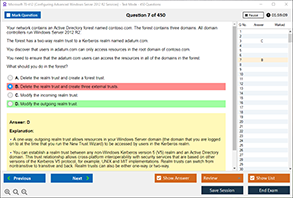Overview of the CompTIA 220-1102 Exam
The CompTIA A+ 220-1102 exam is a core certification exam that validates foundational IT skills. It focuses on software troubleshooting, operating systems, security, and operational procedures, making it essential for anyone entering the IT support field. Passing this exam, along with 220-1101, earns candidates the CompTIA A+ certification, which is globally recognized and highly regarded by employers.
The 220-1102 exam specifically emphasizes operating system installation and configuration, expanded security, software troubleshooting, and operational procedures. A significant portion of the exam involves hands-on knowledge of Windows operating systems and command-line tools, including netsh, a powerful command-line utility.
Understanding tools like netsh is not only crucial for the exam but also in real-world scenarios involving network diagnostics, firewall management, and network interface configurations. That’s why aspiring IT professionals need to master it—and that’s where DumpsBoss becomes an invaluable resource.
What is the netsh Command in Windows?
The netsh (Network Shell) command is a built-in Windows utility that enables users to display and modify network configurations from the command line. It is a powerful administrative tool used by IT professionals to manage and troubleshoot networking problems, often replacing the need for multiple GUI-based steps with concise terminal commands.
Available on most versions of Windows, including Windows 10 and 11, netsh can be executed via the Command Prompt (cmd) or PowerShell. Because of its extensive capabilities and ability to automate networking tasks, netsh is considered a core utility in Windows network management.
Key Purposes of the netsh Command
The netsh command has a wide range of purposes. Here are some of the most critical ones relevant to the CompTIA 220-1102 exam and real-world IT environments:
1. Network Configuration
You can configure both IPv4 and IPv6 settings for adapters using netsh. This includes assigning static IPs, changing DNS servers, and setting gateways.
2. Firewall Management
netsh provides full control over the Windows Firewall. You can enable or disable it, add firewall rules, and open or block ports.
3. Network Diagnostics
netsh helps in diagnosing network problems, such as lost IP configurations or DHCP issues. You can release and renew IP addresses, flush DNS caches, and reset network interfaces.
4. Wireless Configuration
You can use netsh to manage wireless profiles, view SSID details, and export or import wireless settings.
5. Scripting and Automation
Because netsh commands can be used in batch files, it allows automation of routine network tasks, making it a key tool for system administrators.
Common netsh Commands You Should Know
To succeed in the CompTIA 220-1102 exam, you should be familiar with these frequently used netsh commands:
1. View Network Interfaces
Displays all active IPv4 interfaces and their configuration details.
2. Assign Static IP Address
Assigns a static IP, subnet mask, and gateway to a specified adapter.
3. Set DNS Server
Manually sets a static DNS server address.
4. Flush DNS Cache
Clears the ARP cache for troubleshooting.
Note: This is technically not netsh but is commonly used alongside it for DNS troubleshooting.
5. Reset TCP/IP Stack
Resets the TCP/IP stack to its default state—a powerful fix for persistent network issues.
6. Show Firewall Settings
Displays Windows Firewall configuration for all profiles.
7. Enable/Disable Windows Firewall
8. Export Wireless Profiles
Real-Life Scenarios Where netsh is Used
Understanding the netsh command isn't just about passing the CompTIA 220-1102 exam—it's also about using it in real-life IT support roles. Here are some practical scenarios:
Scenario 1: IP Conflict Resolution
An end-user reports that they cannot connect to the network. Using:
Followed by a reboot often clears any TCP/IP misconfigurations causing IP conflicts.
Scenario 2: Reconnecting to Hidden Wi-Fi Networks
By exporting and then importing a previously used wireless profile using:
you can reconnect users to hidden networks quickly.
Scenario 3: Network Outage Troubleshooting
Flushing the DNS cache or resetting network interfaces can often resolve intermittent connectivity issues. Commands like:
and
are go-to tools for Level 1 and Level 2 support technicians.
Scenario 4: Enforcing Network Security Policies
To quickly disable the firewall temporarily during software installations or updates:
To re-enable:
netsh in CompTIA 220-1102 Exam
In the CompTIA 220-1102 exam, you’re not expected to memorize every netsh command but rather understand its functionality and how to apply it in troubleshooting. Here are a few types of questions that may come up:
-
Scenario-Based Questions: You might be given a situation involving network issues and asked to choose the most appropriate command.
-
Command Line Output Interpretation: You could be asked to identify what output or result would be expected after running a specific netsh command.
-
Multiple-Choice Questions: Focused on what a particular command like
netsh int ip resetaccomplishes.
Mastering netsh boosts your chances of scoring high in sections related to operating systems and network troubleshooting, which account for over 40% of the 220-1102 exam.
Tips for Remembering netsh Commands for the Exam
Memorizing command-line syntax can be daunting, but here are tips to retain netsh commands effectively:
-
Use Flashcards: Create flashcards with the command on one side and its function on the other.
-
Group by Function: Organize commands into categories like IP settings, firewall, DNS, wireless, etc.
-
Practice in a Virtual Lab: Install a Windows virtual machine and test commands in real-time.
-
Use Mnemonics: For example, "AIR" for
Address, Interface, Reset. -
Watch Command Walkthrough Videos: Visual learning helps reinforce usage patterns.
-
Simulate Real Issues: Recreate problems like “no internet access” and try resolving them with netsh commands.
How DumpsBoss Can Help with 220-1102 Exam Preparation
When it comes to mastering the CompTIA 220-1102 exam, you don’t have to go it alone. DumpsBoss offers expertly crafted exam dumps, practice questions, and updated guides to give you a competitive edge.
Why Choose DumpsBoss?
-
Latest Questions & Answers: Aligned with the current 220-1102 exam objectives.
-
Detailed Explanations: Each question is explained to reinforce concepts like netsh usage.
-
Real Exam Simulation: Our dumps help you familiarize yourself with the format, time limits, and question complexity.
-
Regular Updates: Stay ahead with dumps that reflect the latest changes in the certification.
-
Affordable & Accessible: Study at your own pace, from any device, without breaking the bank.
By practicing with DumpsBoss resources, you not only boost your exam readiness but also build practical skills applicable to real-world IT support roles.
Conclusion
The netsh command is a vital part of the Windows operating system toolkit—useful for configuring networks, diagnosing connectivity issues, and managing security settings. For anyone preparing for the CompTIA 220-1102 exam, understanding netsh is not just about passing questions but becoming a competent and confident IT professional.
With its wide range of uses and importance in troubleshooting scenarios, netsh is a high-value topic in both the exam and your future IT career. And when paired with trusted preparation materials from DumpsBoss, you can be sure you’re ready to face the challenge.
Whether you're brushing up on syntax, tackling practice questions, or simulating real-world problems, DumpsBoss is your reliable partner in certification success. Start your journey today—and take one step closer to becoming CompTIA A+ certified!
Special Discount: Offer Valid For Limited Time “220-1102 Exam” Order Now!
Sample Questions for CompTIA 220-1102 Dumps
Actual exam question from CompTIA 220-1102 Exam.
What is the purpose of entering the netsh command on a Windows PC?
A) To check disk usage statistics
B) To configure and manage network settings
C) To update the operating system
D) To uninstall software applications



